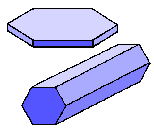- Crystal orientation:
- Plates: more or less horizontal (with tilts)
- Path of light:
- Reflection Halo!
Plates: Reflection at the upper basal face - Occurrence:
- not common
2-8 days a year
EE 09

Description:
Sun pillars are vertical rays of light above or below the sun. In most cases only the upper sun pillar is visible. It is of about the same diameter and colour as the sun. The upper sun pillar can be observed best short after sunset. Then it looks as if the light beam of a bright searchlight is going up vertically from the horizon. At sunset its colour is a kind of orange—white. Some minutes after sunset the pillar becomes more and more orange-red and fades at about 20 to 60 minutes after sunset. When the sun pillar is fully developed, it sometimes has a diffusely en1arged top. That is the upper tangent arc, the “arms” of which form a sharp angle at low sun elevations. In freezing fog, a sun pillar can be more than 30° long. In many cases, however, there is a pillar of only 5 to 10° visible.
When the upper and lower sun pillars are visible together with a part of the parhelic circle, a cross is formed in the sky. In medieval times, such an impressive phenomenon was often considered a sign of God.
Formation:
Sun pillars are caused by the reflection of sunlight on the base ends of rotating plate—shaped and on the prism faces of rotating column—shaped ice crystals. Sun pillars also require ice crystals oscillating around their vertical axis. Sun pillars can also be caused by snow crystals. The formation of a sun pillar can be compared with the path of light (glitter path) formed by the setting sun on a wavy water surface.


